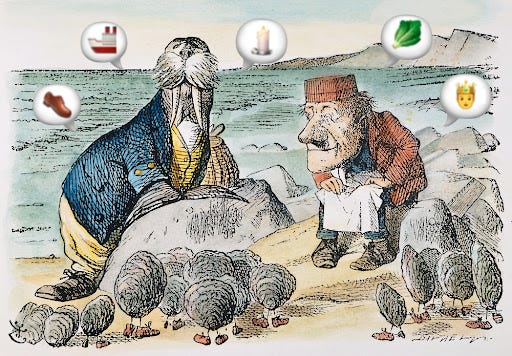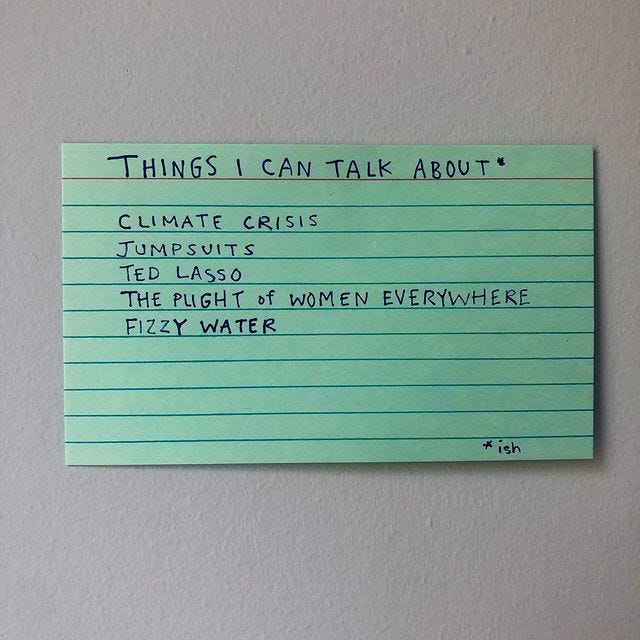Are lists worth the big to-do?
This thought bubbled up from the lamentations for the late literary magazine The Believer. Writing in Gawker, Nicholas Russell recalled how he started at the publication by writing lists:
These were incidental components to each issue that were found throughout the magazine, made up of highly specific collections of observations like Movies Where People Hide the Car Keys in the Visor or Keanu Reeves Movies Where He Plays a Guy Named John.
Are those even stories? Aren’t they just the results of a Google search? Isn’t this a straw man I’m about to light up like Guy Fawkes? A list of answers: Yes, no, yes.
This sent me to The Chatto Book of Cabbages and Kings, an excellent 1989 collection of lists in literature compiled by the polymath Francis Spufford. (I own this book because everything Spufford writes is astonishing and as a bonus, his name springs off the tongue.)
Spufford jumps headfirst into the question of whether lists are an art form at all, and he does it with a pedigree: Alexander Pope wrestled with the same question when translating Homer’s list of ships, an inventory he regarded as a “meer heap of Proper Nouns.”
The unsurprising verdict is that lists have merit as the “most actively constructing and passively recording” way to present information.
“No one scribbles down a helpful sonnet before going shopping,” Spufford notes. “Everyone uses lists.”
The book takes its title from Lewis Carroll’s The Walrus and the Carpenter, who tell an audience of doomed oysters “Of shoes and ships and sealing-wax / Of cabbages and kings.” As Spufford writes, “Carroll has made a thumbnail sketch of everything, his five listed elements representing the idea of profusion in the same way that the single word ‘crown’ stands for the full meaning of the monarchy, but also pulling apart from each other as if you were holding the strings of five balloons in your hand.”
The beauty of a good list is incongruous juxtaposition. Our story-addled brains fill in the blanks, so the bigger the blank, the better the list. This trick is of course best admired in the wild, so here are some cherry-picked items from Spufford’s lists, all linked back to the original source:
1. Selections from Michael Ondaatje’s poem of things your voice sounds like, 1982:
A scorpion being pushed through a glass tube
A crow swimming in milk
A nose being hit by a mango
A dolphin reciting epic poetry to a sleepy audience
3 old ladies locked in the lavatory
2. Cole Porter’s unabashed list of properties, 1916:
A shooting box in Scotland,
A chateau in Touraine,
A silly little chalet
In the Interlaken Valley,A hacienda in Spain,
A private fjord in Norway,
A villa close to Rome,
(And in travelling
It’s really quite a comfort to know
That you’re never far from home!)
3. Cleverest things found in the House O’Shea in James Joyce’s Finnegans Wake, 1939:
Cans of Swiss condensed bilk
Kisses from the antipodes
Broken wafers
Magnifying wineglasses
You Owe Mes
Alphybettyformed verbiage
4. The most obnoxious and harmful types of men, as per Valerie Solanas’s SCUM Manifesto, 1967:
Lousy singers and musicians
Chairmen of Boards
Breadwinners
Landlords
Owners of greasy spoons and restaurants that play Muzak
Men who loiter idly on the street and mar the landscape with their presence
Cops
Tycoons
5. Some of Sydney Smith’s rules for overcoming low spirits, as shared in a letter to Lady Morpeth, 1820:
Amusing books
Short views of human life — not further than dinner or tea
Be as busy as you can
See as much as you can of friends who respect and like you
Don’t expect too much from human life — a sorry business at best
Be as much as you can in the open air without fatigue
6. The three things Dorothy Parker shall never obtain, 1926:
Envy
Content
Sufficient champagne
7. Three things Roland Barthes likes followed immediately (and with no warning!) by four things he doesn’t, 1977:
Loosely held political convictions
Toast
White peaches
White Pomeranians
Strawberries
Tautologies
Evenings with people I don’t know
8. And here’s one Spufford somehow overlooked: Selections from Top Ten Rejected Crayola Colours, from An Altogether New Book of Top Ten Lists by David Letterman and the Late Night With David Letterman writers (1991):
Bruise Purple
Shecky Green
Ochre Winfrey
Jaundice
Quick quips; lightning
“There are three rules for writing a novel. Unfortunately, no one knows what they are.”
— Somerset Maugham
“Only Three People Understood It: The Prince Consort Who is Dead, a German Professor Who Has Gone Mad, and I Who Have Forgotten All About It.”
— Lord Palmerston, referring to Schleswig-Holstein Question
“There were three things that Chico was always on — a phone, a horse, or a broad.”
— Groucho Marx
Furthermore …
Speaking of ...
Listing about wit
What the last two entries of every list should be
Until I hit upon the subject for GWQ No. 121, I was listless. Condensed bilk is a sorry business at best. I highly recommend amusing books like Spufford’s Red Plenty, a factual novel about the moment in time when the Soviet economy looked like it would lead the world. Comrades, 10X that pig iron! I lowly recommend evenings with strawberry toast and Elements of Wit: Mastering The Art of Being Interesting. Push all your scorpions toward the❤️ below.




